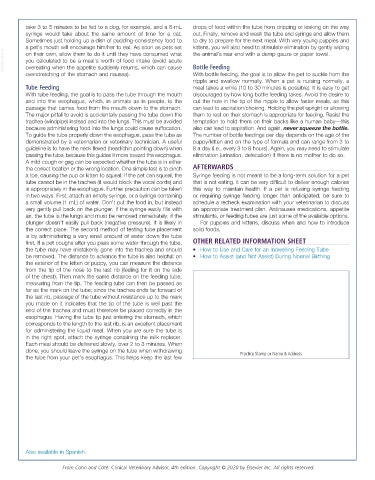Page 3254 - Cote clinical veterinary advisor dogs and cats 4th
P. 3254
take 3 to 5 minutes to be fed to a dog, for example, and a 6-mL drops of food within the tube from dripping or leaking on the way
syringe would take about the same amount of time for a cat. out. Finally, remove and wash the tube and syringe and allow them
Sometimes just holding up a dish of pudding-consistency food to to dry to prepare for the next meal. With very young puppies and
a pet’s mouth will encourage him/her to eat. As soon as pets eat kittens, you will also need to stimulate elimination by gently wiping
VetBooks.ir you calculated to be a meal’s worth of food intake (avoid acute Bottle Feeding
the animal’s rear end with a damp gauze or paper towel.
on their own, allow them to do it until they have consumed what
overeating when the appetite suddenly returns, which can cause
overstretching of the stomach and nausea). With bottle feeding, the goal is to allow the pet to suckle from the
nipple and swallow normally. When a pet is nursing normally, a
Tube Feeding meal takes a while (10 to 30 minutes is possible). It is easy to get
With tube feeding, the goal is to pass the tube through the mouth discouraged by how long bottle feeding takes. Avoid the desire to
and into the esophagus, which, in animals as in people, is the cut the hole in the tip of the nipple to allow faster meals, as this
passage that carries food from the mouth down to the stomach. can lead to aspiration/choking. Holding the pet upright or allowing
The major pitfall to avoid is accidentally passing the tube down the them to rest on their stomach is appropriate for feeding. Resist the
trachea (windpipe) instead and into the lungs. This must be avoided temptation to hold them on their backs like a human baby—this
because administering food into the lungs could cause suffocation. also can lead to aspiration. And again, never squeeze the bottle.
To guide the tube properly down the esophagus, pass the tube as The number of bottle feedings per day depends on the age of the
demonstrated by a veterinarian or veterinary technician. A useful puppy/kitten and on the type of formula and can range from 3 to
guideline is to have the neck flexed (head/chin pointing down) when 8 a day (i.e., every 3 to 8 hours). Again, you may need to stimulate
passing the tube, because this guides it more toward the esophagus. elimination (urination, defecation) if there is no mother to do so.
A mild cough or gag can be expected whether the tube is in either
the correct location or the wrong location. One simple test is to pinch AFTERWARDS
a toe, causing the pup or kitten to squeal. If the pet can squeal, the Syringe feeding is not meant to be a long-term solution for a pet
tube cannot be in the trachea (it would block the vocal cords) and that is not eating. It can be very difficult to deliver enough calories
is appropriately in the esophagus. Further precaution can be taken this way to maintain health. If a pet is refusing syringe feeding
in two ways. First, attach an empty syringe, or a syringe containing or requiring syringe feeding longer than anticipated, be sure to
a small volume (1 mL) of water. Don’t put the food in, but instead schedule a recheck examination with your veterinarian to discuss
very gently pull back on the plunger. If the syringe easily fills with an appropriate treatment plan. Antinausea medications, appetite
air, the tube is the lungs and must be removed immediately; if the stimulants, or feeding tubes are just some of the available options.
plunger doesn’t easily pull back (negative pressure), it is likely in For puppies and kittens, discuss when and how to introduce
the correct place. The second method of testing tube placement solid foods.
is by administering a very small amount of water down the tube
first. If a pet coughs after you pass some water through the tube, OTHER RELATED INFORMATION SHEET
the tube may have mistakenly gone into the trachea and should • How to Use and Care for an Indwelling Feeding Tube
be removed. The distance to advance the tube is also helpful: on • How to Assist (and Not Assist) During Normal Birthing
the exterior of the kitten or puppy, you can measure the distance
from the tip of the nose to the last rib (feeling for it on the side
of the chest). Then mark the same distance on the feeding tube,
measuring from the tip. The feeding tube can then be passed as
far as the mark on the tube; since the trachea ends far forward of
the last rib, passage of the tube without resistance up to the mark
you made on it indicates that the tip of the tube is well past the
end of the trachea and must therefore be placed correctly in the
esophagus. Having the tube tip just entering the stomach, which
corresponds to the length to the last rib, is an excellent placement
for administering the liquid meal. When you are sure the tube is
in the right spot, attach the syringe containing the milk replacer.
Each meal should be delivered slowly, over 2 to 3 minutes. When
done, you should leave the syringe on the tube when withdrawing
the tube from your pet’s esophagus. This helps keep the last few Practice Stamp or Name & Address
Also available in Spanish.
From Cohn and Côté: Clinical Veterinary Advisor, 4th edition. Copyright © 2020 by Elsevier Inc. All rights reserved.

